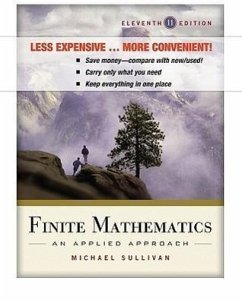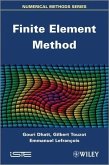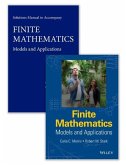Schade – dieser Artikel ist leider ausverkauft. Sobald wir wissen, ob und wann der Artikel wieder verfügbar ist, informieren wir Sie an dieser Stelle.
- Loseblattsammlung
- Merkliste
- Auf die Merkliste
- Bewerten Bewerten
- Teilen
- Produkt teilen
- Produkterinnerung
- Produkterinnerung
This text is an unbound, binder-ready edition. Sullivan's Finite Mathematics: An Applied Approach, Binder Ready Version 11th Edition continues its rich tradition of demonstrating how mathematics applies to various fields of study through its engaging writing style and relevant applications. The purpose of the text is to provide a survey of mathematical analysis techniques used in the working world while also giving students practice in analytical thinking and the application of knowledge to their chosen fields of study. This edition is packed with real data and real-life applications to…mehr
Andere Kunden interessierten sich auch für
![Finite Mathematics Finite Mathematics]() Michael SullivanFinite Mathematics289,99 €
Michael SullivanFinite Mathematics289,99 €![Technology Resource Manual to Accompany Mathematics: An Applied Approach, 8e Technology Resource Manual to Accompany Mathematics: An Applied Approach, 8e]() Michael SullivanTechnology Resource Manual to Accompany Mathematics: An Applied Approach, 8e102,99 €
Michael SullivanTechnology Resource Manual to Accompany Mathematics: An Applied Approach, 8e102,99 €![Finite Element Method Finite Element Method]() Gouri DhattFinite Element Method318,99 €
Gouri DhattFinite Element Method318,99 €![Finite Mathematics Finite Mathematics]() Carla C. MorrisFinite Mathematics162,99 €
Carla C. MorrisFinite Mathematics162,99 €![The Restricted Burnside Problem The Restricted Burnside Problem]() Michael Vaughan-LeeThe Restricted Burnside Problem86,99 €
Michael Vaughan-LeeThe Restricted Burnside Problem86,99 €![Structure Theorems of Unit Groups Structure Theorems of Unit Groups]() Eric JespersStructure Theorems of Unit Groups22,99 €
Eric JespersStructure Theorems of Unit Groups22,99 €![Orders and Generic Constructions of Units Orders and Generic Constructions of Units]() Eric JespersOrders and Generic Constructions of Units37,99 €
Eric JespersOrders and Generic Constructions of Units37,99 €-
-
This text is an unbound, binder-ready edition. Sullivan's Finite Mathematics: An Applied Approach, Binder Ready Version 11th Edition continues its rich tradition of demonstrating how mathematics applies to various fields of study through its engaging writing style and relevant applications. The purpose of the text is to provide a survey of mathematical analysis techniques used in the working world while also giving students practice in analytical thinking and the application of knowledge to their chosen fields of study. This edition is packed with real data and real-life applications to business, economics, and social and life sciences--thereby giving your students the confidence they need succeed in the classroom and beyond. WileyPLUS sold separately from text.
Produktdetails
- Produktdetails
- Verlag: Wiley
- 11th Binder Ready Version edition
- Seitenzahl: 864
- Erscheinungstermin: 29. März 2010
- Englisch
- Abmessung: 254mm x 203mm x 33mm
- Gewicht: 1520g
- ISBN-13: 9780470876398
- ISBN-10: 0470876395
- Artikelnr.: 40212769
- Herstellerkennzeichnung
- Libri GmbH
- Europaallee 1
- 36244 Bad Hersfeld
- gpsr@libri.de
- Verlag: Wiley
- 11th Binder Ready Version edition
- Seitenzahl: 864
- Erscheinungstermin: 29. März 2010
- Englisch
- Abmessung: 254mm x 203mm x 33mm
- Gewicht: 1520g
- ISBN-13: 9780470876398
- ISBN-10: 0470876395
- Artikelnr.: 40212769
- Herstellerkennzeichnung
- Libri GmbH
- Europaallee 1
- 36244 Bad Hersfeld
- gpsr@libri.de
Michael Sullivan is Professor Emeritus in the Department of Mathematics and Computer Science at Chicago State University where he taught for 35 years before retiring a few years ago. Dr. Sullivan is a member of American Mathematical Society, the Mathematical Association of America, and the American Mathematical Association of Two Year Colleges. He is President of Text and Academic Authors Association and represents that organization on the Authors Coalition of America, Mike has been writing textbooks in mathematics for over 30 years. He currently has 13 books in print: 3 texts with John Wiley & Sons and 10 with Prentice-Hall. Six of these titles are co-authored with his son, Michael Sullivan III. He has four children: Kathleen, who teaches college mathematics; Michael, who teaches college mathematics, Dan who is a Prentice-Hall sales representative, and Colleen, who teaches middle school mathematics. Nine grandchildren round out the family.
Chapter 1: Linear Equations.
1.1. Lines.
1.2. Pairs of Lines.
1.3. Applications to Business and Economics.
1.4. Scatter Diagrams; Linear Curve Fitting.
Chapter Review.
Chapter Project.
Chapter 2: Systems of Linear Equations.
2.1 Systems of Linear Equations: Substitution; Elimination.
2.2 Systems of Linear Equations: Gauss-Jordan Method.
2.3 Systems of m Linear Equations Containing n Variables.
Chapter Review.
Chapter Project.
Chapter 3: Matrices.
3.1 Matrix Algebra.
3.2 Multiplication of Matrices.
3.3 The Inverse of a Matrix.
3.4 Applications in Economics (the Leontief Model), Accounting, and
Statistics (the Method of Least Squares).
Chapter Review.
Chapter Project.
Chapter 4: Linear Programming with Two Variables.
4.1 Systems of Linear Inequalities.
4.2 A Geometric Approach to Linear Programming Problems.
Chapter Review.
Chapter Project.
Chapter 5: Linear Programming: Simplex Method.
5.1 The Simplex Tableau; Pivoting.
5.2 The Simplex Method; Solving Maximum Problems in Standard Form.
5.3 Solving Minimum Problems Using the Daily Principle.
5.4 The Simplex Method for Problems Not in Standard Form.
Chapter Review.
Chapter Project.
Chapter 6: Finance.
6.1 Interest.
6.2 Compound Interest.
6.3 Annuities; Sinking Funds.
6.4 Present Value of an Annuity; Amortization.
6.5 Annuities and Amortization Using Recursive Sequences.
Chapter Review.
Chapter Project.
Chapter 7: Probability.
7.1 Sets.
7.2 The Number of Elements in a Set.
7.3 The Multiplication Principle.
7.4 Sample Spaces and the Assignment of Probabilities.
7.5 Properties of the Probability of an Event.
7.6 Expected Value.
Chapter Review.
Chapter Project.
Chapter 8: Bayes' Theorem; The Binomial Probability Model.
8.1 Conditional Probability.
8.2 Independent Events.
8.3 Bayes' Theorem.
8.4 Permutations.
8.5 Combinations.
8.6 The Binomial Probability Model.
Chapter Review.
Chapter Project.
Chapter 9: Statistics.
9.1 Introduction to Statistics: Data and Sampling.
9.2 Representing Qualitative Data Graphically: Bar Graphs; Pie Charts.
9.3 Organizing and Displaying Quantitative Data.
9.4 Measures of Central Tendency.
9.5 Measures of Dispersion.
9.6 The Normal Distribution.
Chapter Review.
Chapter Project.
Chapter 10: Markov Chains; Games.
10.1 Markov Chains and Transition Matrices.
10.2 Regular Markov Chains.
10.3 Absorbing Markov Chains.
10.4 Two-Person Games.
10.5 Mixed Strategies.
10.6 Optimal Strategy in Two-Person Zero-Sum Games with 2 X 2 Matrices.
Chapter Review.
Chapter Project.
Chapter 11: Logic.
11.1 Propositions.
11.2 Truth Tables.
11.3 Implications; The Biconditional Connective; Tautologies.
11.4 Arguments.
11.5 Logic Circuits.
Chapter Review.
Chapter Project.
Appendix A: Review.
A.1 Real Numbers.
A.2 Algebra Essentials.
A.3 Exponents and Logarithms.
A.4 Recursive Defined Sequences: Geometric Sequences.
Appendix B: Using LINDO to Solve Linear Programming Problems.
Appendix C: Graphing Utilities.
C.1 The Viewing Rectangle.
C.2 Using a Graphing Utility to Graph Equations.
C.3 Square Screens.
C.4 Using a Graphing Utility to Graph Inequalities.
Answers to Odd-Numbered Problems.
Photo Credits.
Index.
1.1. Lines.
1.2. Pairs of Lines.
1.3. Applications to Business and Economics.
1.4. Scatter Diagrams; Linear Curve Fitting.
Chapter Review.
Chapter Project.
Chapter 2: Systems of Linear Equations.
2.1 Systems of Linear Equations: Substitution; Elimination.
2.2 Systems of Linear Equations: Gauss-Jordan Method.
2.3 Systems of m Linear Equations Containing n Variables.
Chapter Review.
Chapter Project.
Chapter 3: Matrices.
3.1 Matrix Algebra.
3.2 Multiplication of Matrices.
3.3 The Inverse of a Matrix.
3.4 Applications in Economics (the Leontief Model), Accounting, and
Statistics (the Method of Least Squares).
Chapter Review.
Chapter Project.
Chapter 4: Linear Programming with Two Variables.
4.1 Systems of Linear Inequalities.
4.2 A Geometric Approach to Linear Programming Problems.
Chapter Review.
Chapter Project.
Chapter 5: Linear Programming: Simplex Method.
5.1 The Simplex Tableau; Pivoting.
5.2 The Simplex Method; Solving Maximum Problems in Standard Form.
5.3 Solving Minimum Problems Using the Daily Principle.
5.4 The Simplex Method for Problems Not in Standard Form.
Chapter Review.
Chapter Project.
Chapter 6: Finance.
6.1 Interest.
6.2 Compound Interest.
6.3 Annuities; Sinking Funds.
6.4 Present Value of an Annuity; Amortization.
6.5 Annuities and Amortization Using Recursive Sequences.
Chapter Review.
Chapter Project.
Chapter 7: Probability.
7.1 Sets.
7.2 The Number of Elements in a Set.
7.3 The Multiplication Principle.
7.4 Sample Spaces and the Assignment of Probabilities.
7.5 Properties of the Probability of an Event.
7.6 Expected Value.
Chapter Review.
Chapter Project.
Chapter 8: Bayes' Theorem; The Binomial Probability Model.
8.1 Conditional Probability.
8.2 Independent Events.
8.3 Bayes' Theorem.
8.4 Permutations.
8.5 Combinations.
8.6 The Binomial Probability Model.
Chapter Review.
Chapter Project.
Chapter 9: Statistics.
9.1 Introduction to Statistics: Data and Sampling.
9.2 Representing Qualitative Data Graphically: Bar Graphs; Pie Charts.
9.3 Organizing and Displaying Quantitative Data.
9.4 Measures of Central Tendency.
9.5 Measures of Dispersion.
9.6 The Normal Distribution.
Chapter Review.
Chapter Project.
Chapter 10: Markov Chains; Games.
10.1 Markov Chains and Transition Matrices.
10.2 Regular Markov Chains.
10.3 Absorbing Markov Chains.
10.4 Two-Person Games.
10.5 Mixed Strategies.
10.6 Optimal Strategy in Two-Person Zero-Sum Games with 2 X 2 Matrices.
Chapter Review.
Chapter Project.
Chapter 11: Logic.
11.1 Propositions.
11.2 Truth Tables.
11.3 Implications; The Biconditional Connective; Tautologies.
11.4 Arguments.
11.5 Logic Circuits.
Chapter Review.
Chapter Project.
Appendix A: Review.
A.1 Real Numbers.
A.2 Algebra Essentials.
A.3 Exponents and Logarithms.
A.4 Recursive Defined Sequences: Geometric Sequences.
Appendix B: Using LINDO to Solve Linear Programming Problems.
Appendix C: Graphing Utilities.
C.1 The Viewing Rectangle.
C.2 Using a Graphing Utility to Graph Equations.
C.3 Square Screens.
C.4 Using a Graphing Utility to Graph Inequalities.
Answers to Odd-Numbered Problems.
Photo Credits.
Index.
Chapter 1: Linear Equations.
1.1. Lines.
1.2. Pairs of Lines.
1.3. Applications to Business and Economics.
1.4. Scatter Diagrams; Linear Curve Fitting.
Chapter Review.
Chapter Project.
Chapter 2: Systems of Linear Equations.
2.1 Systems of Linear Equations: Substitution; Elimination.
2.2 Systems of Linear Equations: Gauss-Jordan Method.
2.3 Systems of m Linear Equations Containing n Variables.
Chapter Review.
Chapter Project.
Chapter 3: Matrices.
3.1 Matrix Algebra.
3.2 Multiplication of Matrices.
3.3 The Inverse of a Matrix.
3.4 Applications in Economics (the Leontief Model), Accounting, and
Statistics (the Method of Least Squares).
Chapter Review.
Chapter Project.
Chapter 4: Linear Programming with Two Variables.
4.1 Systems of Linear Inequalities.
4.2 A Geometric Approach to Linear Programming Problems.
Chapter Review.
Chapter Project.
Chapter 5: Linear Programming: Simplex Method.
5.1 The Simplex Tableau; Pivoting.
5.2 The Simplex Method; Solving Maximum Problems in Standard Form.
5.3 Solving Minimum Problems Using the Daily Principle.
5.4 The Simplex Method for Problems Not in Standard Form.
Chapter Review.
Chapter Project.
Chapter 6: Finance.
6.1 Interest.
6.2 Compound Interest.
6.3 Annuities; Sinking Funds.
6.4 Present Value of an Annuity; Amortization.
6.5 Annuities and Amortization Using Recursive Sequences.
Chapter Review.
Chapter Project.
Chapter 7: Probability.
7.1 Sets.
7.2 The Number of Elements in a Set.
7.3 The Multiplication Principle.
7.4 Sample Spaces and the Assignment of Probabilities.
7.5 Properties of the Probability of an Event.
7.6 Expected Value.
Chapter Review.
Chapter Project.
Chapter 8: Bayes' Theorem; The Binomial Probability Model.
8.1 Conditional Probability.
8.2 Independent Events.
8.3 Bayes' Theorem.
8.4 Permutations.
8.5 Combinations.
8.6 The Binomial Probability Model.
Chapter Review.
Chapter Project.
Chapter 9: Statistics.
9.1 Introduction to Statistics: Data and Sampling.
9.2 Representing Qualitative Data Graphically: Bar Graphs; Pie Charts.
9.3 Organizing and Displaying Quantitative Data.
9.4 Measures of Central Tendency.
9.5 Measures of Dispersion.
9.6 The Normal Distribution.
Chapter Review.
Chapter Project.
Chapter 10: Markov Chains; Games.
10.1 Markov Chains and Transition Matrices.
10.2 Regular Markov Chains.
10.3 Absorbing Markov Chains.
10.4 Two-Person Games.
10.5 Mixed Strategies.
10.6 Optimal Strategy in Two-Person Zero-Sum Games with 2 X 2 Matrices.
Chapter Review.
Chapter Project.
Chapter 11: Logic.
11.1 Propositions.
11.2 Truth Tables.
11.3 Implications; The Biconditional Connective; Tautologies.
11.4 Arguments.
11.5 Logic Circuits.
Chapter Review.
Chapter Project.
Appendix A: Review.
A.1 Real Numbers.
A.2 Algebra Essentials.
A.3 Exponents and Logarithms.
A.4 Recursive Defined Sequences: Geometric Sequences.
Appendix B: Using LINDO to Solve Linear Programming Problems.
Appendix C: Graphing Utilities.
C.1 The Viewing Rectangle.
C.2 Using a Graphing Utility to Graph Equations.
C.3 Square Screens.
C.4 Using a Graphing Utility to Graph Inequalities.
Answers to Odd-Numbered Problems.
Photo Credits.
Index.
1.1. Lines.
1.2. Pairs of Lines.
1.3. Applications to Business and Economics.
1.4. Scatter Diagrams; Linear Curve Fitting.
Chapter Review.
Chapter Project.
Chapter 2: Systems of Linear Equations.
2.1 Systems of Linear Equations: Substitution; Elimination.
2.2 Systems of Linear Equations: Gauss-Jordan Method.
2.3 Systems of m Linear Equations Containing n Variables.
Chapter Review.
Chapter Project.
Chapter 3: Matrices.
3.1 Matrix Algebra.
3.2 Multiplication of Matrices.
3.3 The Inverse of a Matrix.
3.4 Applications in Economics (the Leontief Model), Accounting, and
Statistics (the Method of Least Squares).
Chapter Review.
Chapter Project.
Chapter 4: Linear Programming with Two Variables.
4.1 Systems of Linear Inequalities.
4.2 A Geometric Approach to Linear Programming Problems.
Chapter Review.
Chapter Project.
Chapter 5: Linear Programming: Simplex Method.
5.1 The Simplex Tableau; Pivoting.
5.2 The Simplex Method; Solving Maximum Problems in Standard Form.
5.3 Solving Minimum Problems Using the Daily Principle.
5.4 The Simplex Method for Problems Not in Standard Form.
Chapter Review.
Chapter Project.
Chapter 6: Finance.
6.1 Interest.
6.2 Compound Interest.
6.3 Annuities; Sinking Funds.
6.4 Present Value of an Annuity; Amortization.
6.5 Annuities and Amortization Using Recursive Sequences.
Chapter Review.
Chapter Project.
Chapter 7: Probability.
7.1 Sets.
7.2 The Number of Elements in a Set.
7.3 The Multiplication Principle.
7.4 Sample Spaces and the Assignment of Probabilities.
7.5 Properties of the Probability of an Event.
7.6 Expected Value.
Chapter Review.
Chapter Project.
Chapter 8: Bayes' Theorem; The Binomial Probability Model.
8.1 Conditional Probability.
8.2 Independent Events.
8.3 Bayes' Theorem.
8.4 Permutations.
8.5 Combinations.
8.6 The Binomial Probability Model.
Chapter Review.
Chapter Project.
Chapter 9: Statistics.
9.1 Introduction to Statistics: Data and Sampling.
9.2 Representing Qualitative Data Graphically: Bar Graphs; Pie Charts.
9.3 Organizing and Displaying Quantitative Data.
9.4 Measures of Central Tendency.
9.5 Measures of Dispersion.
9.6 The Normal Distribution.
Chapter Review.
Chapter Project.
Chapter 10: Markov Chains; Games.
10.1 Markov Chains and Transition Matrices.
10.2 Regular Markov Chains.
10.3 Absorbing Markov Chains.
10.4 Two-Person Games.
10.5 Mixed Strategies.
10.6 Optimal Strategy in Two-Person Zero-Sum Games with 2 X 2 Matrices.
Chapter Review.
Chapter Project.
Chapter 11: Logic.
11.1 Propositions.
11.2 Truth Tables.
11.3 Implications; The Biconditional Connective; Tautologies.
11.4 Arguments.
11.5 Logic Circuits.
Chapter Review.
Chapter Project.
Appendix A: Review.
A.1 Real Numbers.
A.2 Algebra Essentials.
A.3 Exponents and Logarithms.
A.4 Recursive Defined Sequences: Geometric Sequences.
Appendix B: Using LINDO to Solve Linear Programming Problems.
Appendix C: Graphing Utilities.
C.1 The Viewing Rectangle.
C.2 Using a Graphing Utility to Graph Equations.
C.3 Square Screens.
C.4 Using a Graphing Utility to Graph Inequalities.
Answers to Odd-Numbered Problems.
Photo Credits.
Index.








